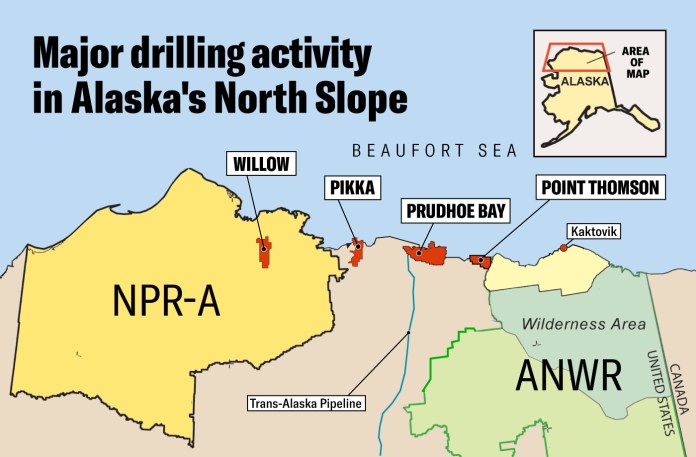The Senate voted on Thursday to walk back environmental protections in Alaska’s National Petroleum Reserve that were imposed by the Biden administration, in Republicans’ latest effort to expand oil and gas drilling in the state.
In a 52-45 vote, the Senate voted in favor of nullifying the National Petroleum Reserve in Alaska Integrated Activity Plan Record of Decision issued by the Bureau of Land Management under former President Joe Biden.
This management plan, finalized in 2022, blocked millions of acres from being available to fossil fuel development, which had been opened during President Donald Trump’s first term.
It specifically allowed around 11.8 million acres of the NPR-A to be open for oil and gas leasing. Subsequently, the region’s remaining 48% of acreage, both onshore and offshore — 11 million acres — was closed.

Sen. Dan Sullivan (R-AK), who sponsored the Senate resolution of disapproval, described the restrictions on drilling in the Indiana-sized area as the “last frontier lockup,” claiming it has threatened U.S. energy independence and jeopardized jobs in the state.
“When you’re producing energy from America, from Alaska, you’re strengthening the country, strengthening good jobs, good union jobs … the other thing you’re doing is you’re helping people live longer,” Sullivan said in remarks on the Senate floor Wednesday.
Sullivan introduced the resolution in September through the Congressional Review Act, a legislative process that allows the majority to bypass a filibuster and vote in a simple majority to undo a regulation.
Republicans have used the CRA throughout the year to reverse and undo numerous Biden administration energy, climate, and environmental regulations.
The Biden plan did not completely remake the guidelines for managing the NPR-A. Instead, it reversed changes made during Trump’s first term.
Broadly, the 2022 management plan reinstates protections and guidance first issued under the Obama administration in 2013.
The first Trump administration sought to expand oil and gas drilling in the NPR-A, opening up 82% of the reserve for development.
In his second term, Trump has sought to take those efforts a step further with the Interior Department spearheading plans to open up nearly the entire reserve for oil and gas exploration.
Last week, the Bureau of Land Management published a call for nominations and comments on what areas in the NPR-A should be made available in the first oil and gas lease sale expected this coming winter.
It will mark the first lease sale in the region since 2019 and is directed to take place under the One Big Beautiful Bill Act signed in July.
If the resolution to nullify the 2022 management plan passes in the House and is signed by Trump, it will make it increasingly easy for the administration to hold frequent lease sales.
As Republicans have moved to reverse the plan through the CRA, it would also block future Democratic administrations from reissuing similar environmental protections in “substantially the same form.”
A similar resolution was introduced in the House by Rep. Nick Begich (R-AK) last month, though there has been little movement for the lower chamber’s version.
TRUMP TAKES STEPS TO OPEN NORTHERN ALASKA TO OIL AND GAS DRILLING
NPR-A, a roughly 23 million-acre area in Alaska’s North Slope Borough, was first set aside by President Warren Harding in 1923 as an emergency oil supply for the U.S. Navy. Jurisdiction of the land was transferred to the Interior Department in the 1970s, opening it up to oil and gas leasing.
While the NPR-A has been open to oil and gas development for decades, Republicans have repeatedly criticized that only around 1.6 million acres have been leased in the region.

